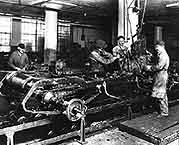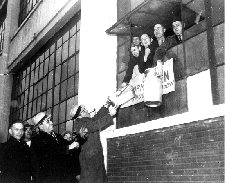| On February 11, 1937, several hundred members of the United Automobile Workers Union (UAW) emerged from three General Motors (GM) factories in Flint, Michigan to the sounds of cheering crowd. These workers had just completed a 44-day sitdown strike. Less than two years old, the UAW had won its first major victory.
Auto factories were tough places to work during the early years of the industry. The pace of work was controlled by the ever-increasing speed of the assembly line and the foreman held the power to hire or fire workers at will. Many jobs were physically demanding, machines had few safety devices, and industrial accidents were common. On August 26, 1935, auto workers organized the UAW to bargain for better wages and working conditions.
The Flint Sitdown began on December 30, 1936 when UAW leaders decided to call a strike against GM. The goal of the strike was simple: GM recognition of the UAW. For over six weeks members of the UAW stopped production and refused to leave the plants they occupied. They slept on unfinished car seats, eating food their families and friends slipped through factory windows. They faced tear gas attacks, heat shutoffs, and battled with police and company security guards. Michigan Governor Frank Murphy sent in the National Guard to maintain order.
Faced with an enormous loss of production, GM conceded to the strikers' demands and signed a one-page document, agreeing to bargain with the UAW. This was one of the key events in American labor history.
|

General Motors assembly line, 1920s.

Passing food to Sitdown strikers inside Fisher Body Plant Number 1, 1937.

Michigan National Guard confronting union supporters outside GM plants in Flint, 1937
|